
Improving Member States preparedness to face an HNS pollution of the Marine System (HNS-MS)
Acrylonitrile
Description Top
| CAS number | 107-13-1 |
| UN number | 1093 |
| Chemical formula | C3H3N |
| Accident occurred | Yes |
| Standard European Behaviour Classification (SEBC) | Dissolver that evaporates (DE) |
| Notable risks | Oxidizer. Polymerization. |
GESAMP Hazard profile
| A1 | A2 | B1 | B2 | C1 | C2 | C3 | D1 | D2 | D3 | E1 | E2 | E3 |
| 2 | NR | 3 | 0 | 2 | 3 | 3 | 2 | 2 | CMSs | NT | DE | 3 |
Marine pollution Classification (MARPOL Annex II)
| Category | Description |
| Y | Noxious Liquid Substances which, if discharged into the sea from tank cleaning or deballasting operations, are deemed to present a hazard to either marine resources or human health or cause harm to amenities or other legitimate uses of the sea and therefore justify a limitation on the quality and quantity of the discharge into the marine environment. |
Alternate names for this chemical
Acrylonitrile Monomer
Cyanoethylene
2-Propenenitrile
Propenoic Acid Nitrile
Vinyl Cyanide
Cyanure De Vinyle
Nitrile Acrylique
Acrylonitrile
Cyanoethylene
2-Propenenitrile
Propenoic Acid Nitrile
Vinyl Cyanide
Cyanure De Vinyle
Nitrile Acrylique
Acrylonitrile
Physico-chemical properties Top
| Chemical formula | C3H3N | ||
| Molar mass | 53.06 [g/mol] | ||
| Critical molar volume | 0.000173 [m³/mol] | ||
| State | Liquid at 25°C and 1 atm | ||
| Fusion temperature | -83 [°C] | ||
| Boiling temperature | 77.4 [°C] | ||
| Critical temperature | 540 [°C] | ||
| Density |
|
||
| Surface tension |
|
||
| Kinematic viscosity |
|
||
| Hydrosolubility |
|
||
| Vapour pressure |
|
||
| Critical pressure | 4660000 [Pa] | ||
| Vapour density | 1.9 | ||
| Flash point (Pensky-Martens closed cup) | -1 [°C] | ||
| Lower explosivity limit (LEL) | 3 [%] | ||
| Upper explosivity limit (UEL) | 17 [%] | ||
| Vaporization enthalpy |
|
||
| Combustion enthalpy | 31900000 [J/Kg] | ||
| Specific heat capacity | 2050 [J/(Kg·K)] | ||
| Combustion efficiency | 98 [%] | ||
| Mass flow rate of the combustion surface | 0.05 [Kg/(m²·s)] | ||
| Radiative fraction | 26 [%] | ||
| Henry's constant | 8.7 [mol/(m³·Pa)] |
Behaviour Top
| Log Kow | -0.92 |
| Log Koc | -0.07 |
| Hydrolysis (Half-life) | Not hydrolysable |
| Aqueous photolysis (Half-life) | Not photolysable |
| Biodegradation in estuary environment (Half-life) | Not biodegradable |
| Biodegradation in marine environment (Half-life) | Not biodegradable |
| Standard European Behaviour Classification (SEBC) | Dissolver that evaporates (DE) |
| Bioconcentration factor (BCF) | 1 |
Ecotoxicity Top
| Lowest median lethal concentration (LC50) on algae | 1.63 [mg/l] | ||
| Lowest median lethal concentration (LC50) on crustacean | 6 [mg/l] | ||
| Lowest median lethal concentration (LC50) on fishes | 5.16 [mg/l] | ||
| Highest no observed effect concentration (NOEC) on algae | 0.8 [mg/l] | ||
| Highest no observed effect concentration (NOEC) on crustacean | 0.5 [mg/l] | ||
| Highest no observed effect concentration (NOEC) on fishes | 0.17 [mg/l] | ||
| Assessment factor (AF) |
|
||
| Predicted No Effect Concentration (PNEC) |
|
Hazards Top
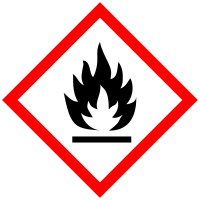
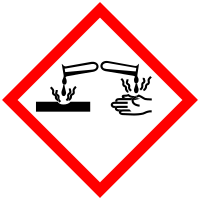
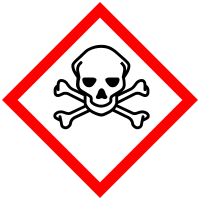
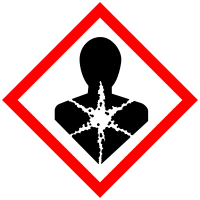
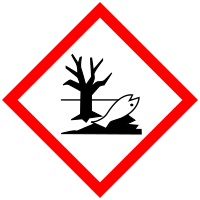
Danger
| IDLH | 85 [ppm] |
Hazards statements
Physical
H225
Highly flammable liquid and vapour.
Health
H301
Toxic if swallowed.
H311
Toxic in contact with skin.
H317
May cause an allergic skin reaction.
H318
Causes serious eye damage.
H331
Toxic if inhaled.
H335
May cause respiratory irritation.
H350
May cause cancer.
Environmental
H411
Toxic to aquatic life with long lasting effects.
Precautionary statements
Prevention
P201
Obtain special instructions before use.
P202
Do not handle until all safety precautions have been read and understood.
P210
Keep away from heat/sparks/open flames/hot surfaces. No smoking.
P231
Handle under inert gas.
P242
Use only non-sparking tools.
P243
Take precautionary measures against static discharge.
P260
Do not breathe dust/fume/gas/mist/vapours/spray.
P262
Do not get in eyes, on skin, or on clothing.
P270
Do no eat, drink or smoke when using this product.
P272
Contaminated work clothing should not be allowed out of the workplace.
P273
Avoid release to the environment.
P280
Wear protective gloves/protective clothing/eye protection/face protection.
P284
Wear respiratory protection.
Response
P331
Do NOT induce vomiting.
P301 + P310
IF SWALLOWED: Immediately call a POISON CENTER or doctor/physician.
P302 + P352
IF ON SKIN: Wash with plenty of soap and water.
P304 + P340
IF INHALED: Remove victim to fresh air and keep at rest in a position comfortable for breathing.
P305 + P351 + P338
IF IN EYES: Rinse cautiously with water for several minutes. Remove contact lenses, if present and easy to do. Continue rinsing.
P370 + P378
In case of fire: Use ... for extinction.
Storage
P405
Store locked up.
P403 + P233
Store in a well-ventilated place. Keep container tightly closed.
Disposal
P501
Dispose of contents/container to ...
GESAMP Top
GESAMP Hazard profile
| A1 | A2 | B1 | B2 | C1 | C2 | C3 | D1 | D2 | D3 | E1 | E2 | E3 |
| 2 | NR | 3 | 0 | 2 | 3 | 3 | 2 | 2 | CMSs | NT | DE | 3 |
A1: Bioaccumulation
| Rating | Description |
| 2 | Low potential to bioaccumulate |
A1a:
| Rating | Description | Criteria [mg/l] |
| 0 | No potential to bioaccumulate | Log Kow < 1 |
A1b:
| Rating | Description | Criteria |
| 2 | Low potential to bioaccumulate | 10 ≤ BCF < 100 |
A2: Biodegradation
| Rating | Description |
| NR | Not readily biodegradable |
B1: Acute aquatic toxicity
| Rating | Description | Criteria [mg/l] |
| 3 | Moderately toxic | 1 < LC/EC/IC50 ≤ 10 |
B2: Chronic aquatic toxicity
| Rating | Description | Criteria [mg/l] |
| 0 | Negligible | NOEC > 1 |
C1: Acute oral toxicity
| Rating | Description | Criteria [mg/Kg] |
| 2 | Moderate | 50 < AOTE ≤ 300 |
C2: Acute dermal toxicity (skin contact)
| Rating | Description | Criteria [mg/Kg] |
| 3 | Moderately high | 50 < ADTE ≤ 200 |
C3: Acute inhalation toxicity
| Rating | Description | Criteria [mg/l] (4 hours exposure) |
| 3 | Moderately high | 0.5 < AITE ≤ 2 |
D1: Skin irritation or corrosion
| Rating | Description | Sign | GHS category |
| 2 | Irritating | Marked erythema, Obvio | Irritant Category 2 |
D2: Eye irritation
| Rating | Description | Sign | GHS category |
| 2 | Irritating | Marked conjunctival hy | Irritant Category 2A |
D3: Long-term health effects
| Notation | Hazard endpoint | Description | GHS category |
| C | Carcinogenicity | Chemicals which have been shown to induce or increase the incidence of cancer | Category 1 for Carcinogens |
| M | Mutagenicity | Cause a permanent change in the amount or structure of genetic material in cells | Categories 1 and 2 for Germ Cell Mutagens |
| Ss | Skin Sensitization | Cause specific skin hypersensitivity or allergy following skin contact | Category 1 for Skin Sensitizers |
E1: Tainting of seafood
| Rating | Description |
| NT | The substance has been tested for tainting and found not to taint following exposure of the fish for 24h to 1mg/l. |
E2: Behaviour of chemicals in the marine environment
| Rating | Description |
| DE | Dissolver that evaporates |
E3: Interference with the use of coastal amenities
| Rating | Interference | Description | Interpretation | Warning |
| 3 | Highly objectionable | 1 is highly acutely toxic; and/or 2 is severely irritant or corrosive to skin or eyes; and/or 3 is carcinogenic, mutagenic or reprotoxic; and/or 4 is a floater or persistent floater with associated health effects | 1 C1 and/or C2 and/or C3 = 4; and/or 2 D1 or D2 = 3, 3A, 3B, or 3C; and/or 3 D3 contains C, M or R; and/or 4 E2 = F or Fp and D3 contains Ss, Sr, T, A, N, or I | Warning issued leading to the closure of amenities |
GHS Security Information





Danger
About the project
HNS-MS is a decision-support tool that Belgian and French maritime authorities as well as coastguard stations can activate in order to forecast the drift, fate and behavior of acute marine pollution by Harmful Noxious Substances (HNS) accidentally released in the marine system.
Contact us
Copyright © 2015–2026 HNS-MS Consortium
 HNS-MS has been funded by DG-ECHO under agreement ECHO/SUB/2014/693705 and runs from 1 January 2015 to 31 March 2017.
HNS-MS has been funded by DG-ECHO under agreement ECHO/SUB/2014/693705 and runs from 1 January 2015 to 31 March 2017.